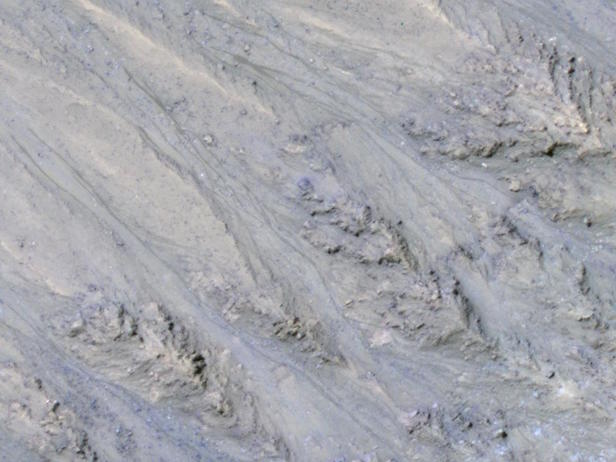New evidence argues against water on Mars’ surface
As dark streaky features extend down the Red Planet’s slopes, scientists now believe it is due to the movement of sand grains and not subsurface water

NASA’s MRO has been watching the Martian surface since 10 March 2006. Image credit: NASA/JPL
The search for signs of water on the Red Planet continues, but recent research has been dealt a blow with its analysis of Mars’ downhill, dark, surface streaks. By using NASA’s Mars Reconnaissance Orbiter (MRO) and its High Resolution Imaging Science Experiment (HiRISE) camera, scientists have presented strong evidence that these dark features are not due to subsurface flowing water, but instead granular flows.
MRO has continued to observe the ever-confusing seasonal dark streaks since their discovery in 2011, when scientists claimed they could be a source of enough water to support microbial life. The recent evidence from MRO has shown that the dark features exist only on slopes steep enough for dry grains to descend the way they do on faces of active dunes.
They seasonal behaviour of these dark features consists of extending gradually downhill in warm seasons, then they disappear in the winter and repeat this pattern the next year. Seeping water has shown this sort of geological behaviour on Earth, but how this occurs on the Martian surface is very unclear. The scientists who conducted the research have suggested that there could be very small amounts of water involved. This is supported by the detection of hydrated salts – water molecules in a crystal form – that were observed at some flow sites.
These features have been given the term “recurring slope lineae”, or RSL for short. There has been a abundance of detections, having been identified in more than 50 rocky-slope areas, ranging in location from the equator to halfway to the poles.
Colin Dundas, of the U.S. Geological Survey’s Astrogeology Science Centre in Flagstaff, Arizona, United States, along with his team surveyed 151 RSL features at 10 different sites. From this, they gathered 3-D models of slope steepness using pairs of images for stereo information. Dundas says, “We’ve thought of RSL as possible liquid water flows, but the slopes are more like what we expect for dry sand. This new understanding of RSL supports other evidence that shows that Mars today is very dry.”

One of the 10 sites that exhibit RSL is near the southern rim of Mars’ Tivat Crater. Image credit: NASA/JPL-Caltech/UA/USGS
Out of all the RSL surveyed, almost all of them have a steepness of at least 27 degrees. The flow ends on a slope that matches the “angle of repose” seen in the slumping dry sands of dunes on Mars and Earth. Alfred McEwen, HiRISE Principal Investigator, says, “The RSL don’t flow onto shallower slopes, and the lengths of these are so closely correlated with the dynamic angle of repose, it can’t be a coincidence.”
These seasonal ever-changing streaks were originally thought to evidence for the presence of liquid water, enough that would be adequate for microbial life. Unfortunately for a lot of hopeful astronomers, the granular-flow explanation for RSLs corresponds with our earlier understanding of the surface of Mars, which is a cold, dry planet with an extremely thin atmosphere. Liquid water on the surface of the Red Planet seems to be limited to traces of dissolved moisture from the atmosphere and thin films, making Mars’ surface virtually inhospitable.
It’s important to note that this is not a complete explanation of the occurrence of RSLs. There are several aspects that cannot be explained yet, such as their gradual growth, their seasonal reappearance, their rapid fading when inactive and the presence of hydrated salts. Scientists conducting this research have drawn some possible connections between these traits are how RSL form, though. One example is that water from the minute atmosphere can be plucked out and hydrate the salts, forming drops of salty water. The seasonal changes in the hydration of salt-containing grains could be a trigger mechanism that starts the granular downfall. The changes in hydration could always be what causes the darkening and fading effect within the features. If this were in fact the case, this wouldn’t explain why RSLs only appear on some slopes and not others.
“RSL probably form by some mechanism that is unique to the environment of Mars,” McEwen says. “So they represent an opportunity to learn about how Mars behaves, which is important for future surface exploration.”
“Full understanding of RSL is likely to depend upon on-site investigation of these features,” says Rich Zurek, MRO Project Scientist. “While the new report suggests that RSL are not wet enough to favour microbial life, it is likely that on-site investigation of these sites will still require special procedures to guard against introducing microbes from Earth, at least until they are definitively characterized. In particular, a full explanation of how these enigmatic features darken and fade still eludes us. Remote sensing at different times of day could provide important clues.”
Keep up to date with the latest reviews in All About Space – available every month for just £4.99. Alternatively you can subscribe here for a fraction of the price!




